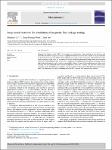Thông tin tài liệu
Thông tin siêu dữ liệu biểu ghi
| Trường DC | Giá trị | Ngôn ngữ |
|---|---|---|
| dc.contributor.advisor | Cong-Thuong Pham | - |
| dc.contributor.advisor | Jinyi Lee | - |
| dc.contributor.author | Minhhuy Le | - |
| dc.date.accessioned | 2021-07-05T08:00:04Z | - |
| dc.date.available | 2021-07-05T08:00:04Z | - |
| dc.date.issued | 2021 | - |
| dc.identifier.uri | https://www.sciencedirect.com/science/article/abs/pii/S0263224120312306?via%3Dihub#! | - |
| dc.identifier.uri | https://dlib.phenikaa-uni.edu.vn/handle/PNK/1933 | - |
| dc.description | Q1 | vi |
| dc.description.abstract | Magnetic flux leakage testing (MFLT) is an important nondestructive testing method for the detection and evaluation of defects in magnetic materials. Magnetic field distribution in an MFLT system is usually simulated by the finite element method (FEM), which required large memory, high computation, and complication of the meshing process. In this paper, an alternative simulation method will be proposed using a deep neural network (DNN). The DNN method provides an easy way of simulation by feeding only the distribution of supplied current and the physical properties such as magnetic permeability without the need for the meshing process. Defects with arbitrary sizes were simulated under different configurations of the MFLT systems. The DNN was trained on the simulation results of the FEM and provided an accurate prediction of the magnetic field distribution of the unseen data. This study paves the way for designing optimized MFLT systems in a bigdata-driven method. | vi |
| dc.language.iso | en | vi |
| dc.publisher | Measurement | vi |
| dc.subject | Deep learning | vi |
| dc.subject | Machine learning | vi |
| dc.subject | MFLT | vi |
| dc.subject | FEM | vi |
| dc.title | Deep neural network for simulation of magnetic flux leakage testing | vi |
| dc.type | Article | vi |
| eperson.identifier.doi | 10.1016/j.measurement.2020.108726 | - |
| Bộ sưu tập | ||
| Bài báo khoa học | ||
Danh sách tệp tin đính kèm:

